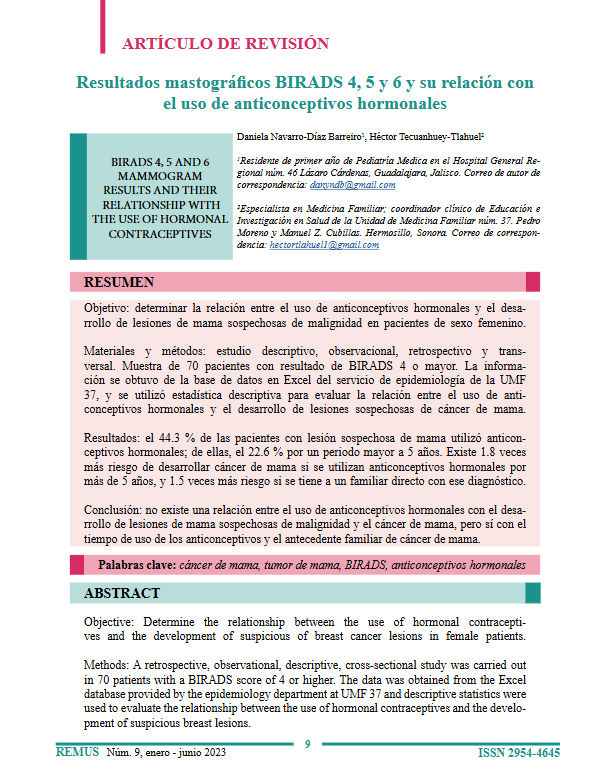BIRADS 4, 5 AND 6 MAMMOGRAM RESULTS AND THEIR RELATIONSHIP WITH THE USE OF HORMONAL CONTRACEPTIVES
Resultados mastográficos BIRADS 4, 5 y 6 y su relación con el uso de anticonceptivos hormonales
DOI:
https://doi.org/10.59420/remus.9.2023.154Keywords:
breast cancer, breast tumor, BIRADS, hormonal contraceptivesAbstract
Objective: Determine the relationship between the use of hormonal contraceptives and the development of suspicious of breast cancer lesions in female patients. Methods: A retrospective, observational, descriptive, cross-sectional study was carried out in 70 patients with a BIRADS score of 4 or higher. The data was obtained from the Excel database provided by the epidemiology department at UMF 37 and descriptive statistics were used to evaluate the relationship between the use of hormonal contraceptives and the development of suspicious breast lesions. Results: 44.3 % of the patients with a suspicious breast lesion had used hormonal contraceptives, 22.6 % of whom had used them for more than 5 years. There is a 1.8 higher risk of developing
breast cancer if hormonal contraceptives are used for longer than 5 years and a 1.5 higher risk if a direct family member has developed it. Conclusion: There is no relationship between the use of hormonal contraceptives and the development of suspicious breast lesions and breast cancer, but it is related to the length of use and family history of breast cancer.
Downloads
References
Kahlenborn C., Modugno F, Potter DM, Severs WB. Uso de anticonceptivos orales como factor de riesgo de cáncer de mama premenopáusico: un metaanálisis. Mayo Foundation for Medical Education and Research, editor. Mayo Clin Proc. 2006; 81(10):1290–302. Disponible en: http://contracep-cion.info/Mayo-Clin-Proc_200610_Breast-can-cer-pill_8110a1_es-t.pdf
Organización Mundial de la Salud. Cáncer de mama. Who.int. World Health Organization: WHO; 2021. Disponible en: https://www.who.int/es/news-room/fact-sheets/detail/breast-cancer
Osorio N, Bello C, Vega L. Factores de riesgo asociados al cáncer de mama. Revista Cubana de Medicina General Integral. 2020; 36(2):1147. Disponible en: https://www.medigraphic.com/pdfs/revcubmedgenint/cmi-2020/cmi202i.pdf
Sun YS, Zhao Z, Yang ZN, Xu F, Lu HJ, Zhu ZY, Shi W, Jiang J, Yao PP, Zhu HP. Risk Factors and Preventions of Breast Cancer. Int J Biol Sci. 2017 Nov 1; 13(11):1387-1397. doi: 10.7150/ijbs.21635. PMID: 29209143; PMCID: PMC5715522. Disponible en: https://www.ncbi.nlm.nih.gov/pmc/arti-cles/PMC5715522/
Bucheli Terán R, Noboa Flores E, editors. Anti-concepción hormonal. Segunda edición. Ecua-dor: Quito: Imprenta Mariscal Cía.; 2021. Disponible en: https://codeser.org/wp-content/uploads/2021/05/2021-Anticoncepcio%CC%81n-Hor-monal-Segunda-Edicio%CC%81n-Bucheli-No-boa.pdf#page=531
Delgado Rodríguez M, Sillero Arenas M, Rodríguez Contreras R, Bueno Cavanillas A, Martín Moreno JM, Gálvez R. Anticonceptivos orales y cáncer de mama: análisis de la potencia estadística de la asociación. Gaceta Sanitaria. 5(23): 59–67. Disponible en: https://www.sciencedirect.com/science/article/pii/S0213911191710480
Instituto Nacional de Cáncer.Píldoras anticonceptivas y el riesgo de cáncer. 2018. Disponible en: https://www.cancer.gov/espanol/cancer/cau-sas-prevencion/riesgo/hormonas/hoja-informati-va-pildoras-anticonceptivas
Wingo PA, Austin H, Marchbanks PA. El uso de anticonceptivos orales no tiene impacto en la mor-talidad por cáncer de mama. Revista Colombiana de Menopausia. 2008; 14(2):139–40. Disponible en: https://www.asomenopausia.com/r/14_2.pd-f#page=55
Leal F. J, Vargas S. F, Taladriz R C. ¿Son los anti-conceptivos orales un factor de riesgo para el desarrollo de cáncer de mama? REV CHIL OBSTET GINECOL. 2007; 72(2):89–95. Disponible en: ht-tps://www.scielo.cl/pdf/rchog/v72n2/art04.pdf
Vásquez-Awad D, Ospino AM. Anticonceptivos orales combinados. Ginecol Obstet Mex [Internet]. 2020; 88(1):S13–31. Disponible en: https://www.medigraphic.com/pdfs/ginobsmex/gom-2020/goms201d.pdf
Sánchez D, Zaira L. Fibromas en mujeres relacionado al uso de anticonceptivos hormonales. [Tesis de Licenciatura]. Universidad Autónoma del Esta-do de México; 2021. Disponible en: http://ri.uae-mex.mx/handle/20.500.11799/112434
Madrigal Ureña A, Mora Rosenkranz B. Breast cancer overview for general practitioner. Medicina Legal de Costa Rica Edición Virtual. 2018 Mar; 35(1). Disponible en: https://www.scielo.sa.cr/pdf/mlcr/v35n1/1409-0015-mlcr-35-01-44.pdf
Maffuz-Aziz A, Labastida-Almendaro S, Espejo-Fonseca A, Rodriguez-Cuevas S. Clinical and pathological features of breast cancer in a population of Mexico. Masson Doyma México S.A, editor. Cirugía y Cirujanos. 2017; 85(3):201. Dis-ponible en: https://www.sciencedirect.com/scien-ce/article/pii/S000974111630069X
López T. M, Pesci Feltri A, García F. I, Guida V, Fernandes A, Blanch R. Factores de riesgo y protectores asociados al cáncer de mama. Revista Venezolana de Oncología. 2017; 29(2). Disponible en: https://www.redalyc.org/articulo.oa?id=375650363005

Downloads
Published
How to Cite
Issue
Section
License
Copyright (c) 2023 REMUS - Revista Estudiantil de Medicina de la Universidad de Sonora (Journal of Medical Students' of the University of Sonora)

This work is licensed under a Creative Commons Attribution-NonCommercial-NoDerivatives 4.0 International License.

